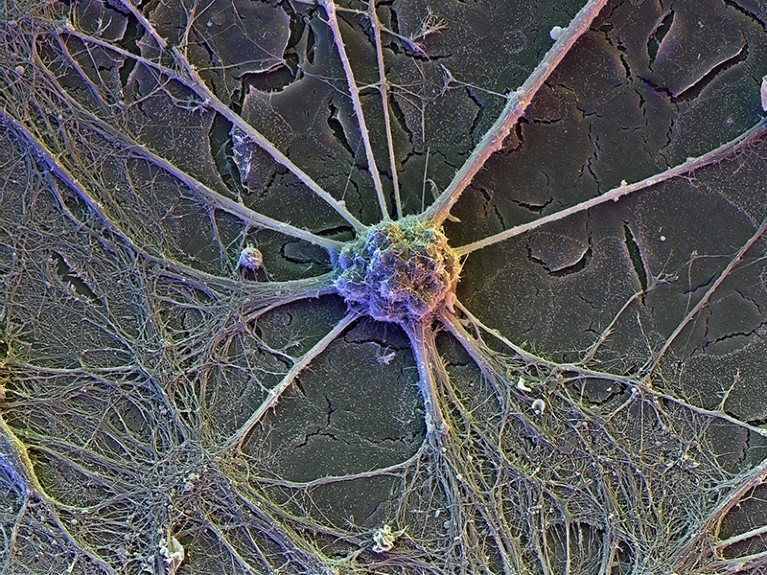
A nerve cell in the human brain, seen in a false colour under a scanning electron microscope.Credit: David Scharf/SPL
The Consciousness Instinct: Unraveling the Mystery of How the Brain Makes the Mind Michael S. Gazzaniga Farrar, Straus and Giroux: 2018.
In April 1648, a young admirer of René Descartes visited the French philosopher at his estate on the Dutch coast. Aiming to discuss the cardinal points of Cartesian philosophy, Frans Burman had marked more than 70 passages in Descartes’s works. How, he asked, can soul and body affect each other, given their fundamental difference? Descartes conceded that the question was thorny, but pointed to the evidence that they do — for instance, in emotion. The mystery lies in the mechanism, and this, Descartes confided, was perhaps best left to theologians.
Neuroscientist Michael Gazzaniga tackles this abiding mind–body problem anew in The Consciousness Instinct. His subtitle, Unraveling the Mystery of How the Brain Makes the Mind, rephrases Descartes’s conundrum into a bold promise. But then, Gazzaniga is a bold scientist. He made his name in the 1960s through pioneering work on severing the connection between the brain’s left and right hemispheres (‘split brains’), as his autobiography vividly details (D. Draaisma Nature 518, 298–299; 2015).
His latest book is certainly evidence that scholars advancing in age (Gazzaniga is now 78) often trust themselves with ever broader scientific and philosophical questions. Thus he guides readers through neurology, biology and psychology, discussing the origin and neural underpinnings of language or the mechanism of facial recognition. And he evokes Isaac Newton’s laws of motion, the special and general theories of relativity and quantum physics — surprisingly, for a man with a self-confessed blind spot for mathematical abstraction.
The tour yields a couple of useful lessons. With theoretical biologist Howard Pattee, Gazzaniga emphasizes that we should resist the lure of the “single-explanation fallacy” — the idea that one theory can cover everything, from our introspective sense of awareness down to the subatomic particles of brain tissue. Explanations, he asserts, should be thought of as context-dependent, just as light in quantum physics sometimes behaves like waves and sometimes like particles.
Gazzaniga defines consciousness as “the subjective feeling of a number of instincts and/or memories playing out in time in an organism”. He points out that clinical cases — he spent a few years working on neurological wards — add complexities. For instance, people who are completely unable to move can still be conscious, a frightening condition called locked-in syndrome. Consciousness might be absent in sleepwalking. Thus, coupling it to behaviour is misleading.
Nor is it straightforward to link consciousness to parts of the brain. One of Gazzaniga’s earliest findings was that disconnecting the left and right hemispheres produced two separate conscious systems; only one, usually supported by the left brain, was able to express itself in language. It had been assumed that consciousness co-evolved with the cerebral cortex, supporting ‘higher’ functions such as language and reasoning. But referring to the work of neuroscientist Björn Merker, Gazzaniga makes the case that consciousness might not be necessarily — or exclusively — locked into cortical and linguistic processes. In some children born with a seriously compromised forebrain, the damaged tissue gets replaced by fluid (hydranencephaly). They grow up lacking language, but still express feelings and have subjective experiences. According to Gazzaniga, consciousness might actually originate in the evolutionarily older midbrain, with the cortex providing “a collection of extensions (apps!) to enhance conscious experiences”.
In an engaging discussion of the brain’s architecture, he offers a mundane simile for consciousness. The brain should be thought of as a multitude of modules, each specialized for a single task, such as recognizing patterns or monitoring rhythm in music. The end products of these modules rise to the surface and burst like “bubbles in a boiling pot of water”, each a fleeting part of our awareness. Our subjective sense of continuity, described by pioneering psychologist William James as “stream of consciousness”, might be illusion: we merely experience the rapid succession of elements as a smooth movement, like the frames of a film. The metaphor of the bubbles seems first and foremost an invitation to generate a testable theory, and Gazzaniga’s observations will almost certainly provide much of the test material.
Gazzaniga ends by reflecting that the ultimate explanation for how mind emerges from meat might not prove “warm and cuddly”. Instead, it might vie with quantum mechanics for sheer counter-intuitive weirdness, hovering “way beyond our intuitions and imaginations”. Once again we seem to hear what Burman heard, 370 years ago: a sigh of resignation, as Descartes indicated that it might all be better left to the theologians.

 Neuroscience: Halving it all
Neuroscience: Halving it all
 Joined-up thinking
Joined-up thinking
 The mind mapped
The mind mapped
 Drama of consciousness
Drama of consciousness








